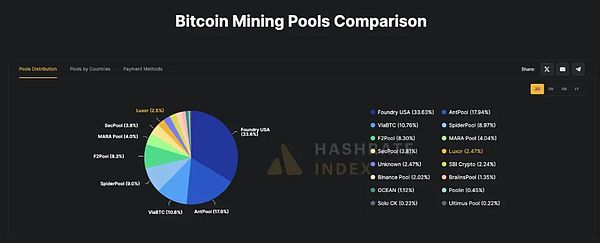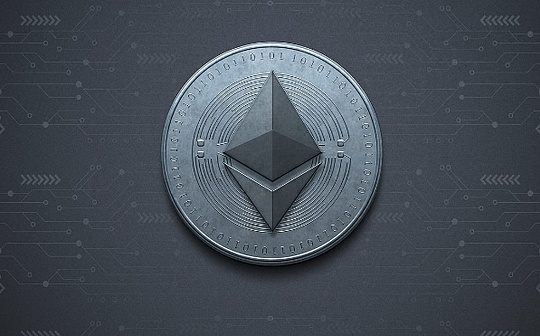
A few days ago, the Jiaolian article introduced the suspected Qubic mining pool and its claim that it had successfully implemented a so-called 51% attack on Monero by controlling more than half of the total power of Monero, and rejecting other miners in a selfish way, thus achieving a monopoly on accounting rights.
Yesterday, on August 19, netizen @l3olanza discovered that the computing power of the top two BTC mining pools has exceeded half of the total computing power of the entire network.This means that if they conspire, they may be eligible for a 51% attack on the BTC network.

These two major mining pools are Foundry USA, which accounts for 33.6% of the computing power and AntPool (Ant Pool), which accounts for 17.9%.The sum of the two is 51.5% > 51%.
In response, netizen @CPOfficialtx believes: “It takes two mining pools to conspire to pose a threat to BTC… but this may not happen. No one, including miners, is willing to suffer losses. However, this is not the first time that two or more mining pools have controlled more than 51% of their computing power.”
Netizen @uonnaberich pointed out the historical case: “This statement is not accurate. If miners detect malicious behavior, they can easily switch the mining pool. This happened in 2014 – when the computing power of the GHash.io mining pool was close to 51% of the entire BTC network, the miners spontaneously evacuated, causing their share to fall to about 38%, and quickly restored the ecological balance.”
Netizen @JacobKinge was frightened to find out, “Foundry USA just dug out eight blocks in a row. This is simply shocking! Even many BTC veterans I know have started to panic. For many years, I have been warning everyone that the centralization of BTC is extremely dangerous. A small group of miners and insiders control the network and manipulate prices. This incident is the latest ironclad evidence. There is also a more dangerous signal: the blocks are empty now, and the handling fee plummets to 1 Satoshi/byte. To be honest, no one uses BTC at all.”

Netizen @JeffPasquino pointed out that this is just a simple question of probability: “As of last year, Foundry’s computing power accounted for about 32%.The probability of digging out 7 blocks in a row is only 0.03% (about 1 in 3300).But the core is: what is the probability of digging out 6 more blocks in succession after they have dug out?And how long should they be able to dig out a block?According to one-third of the computing power, Foundry should be able to dig out 2 blocks per hour – that is, 48 blocks per day.The probability of digging out 6 blocks in succession is 0.1%.Therefore, the probability of Foundry digging out 7 blocks in a row in any day is 4.8%.This also means that the probability of achieving such continuous digging records once a month (>1%) far exceeds mathematical expectations.Mathematics is really interesting.”
Netizen @CsTominaga said sarcastically: “Ah, believers are starting to make a fuss again – Foundry dug out eight blocks in a row, and the sky collapsed. Mastering 40% of computing power to dig eight in a row? This is not a black magic, but a probability learning stretches. Chapter 5 of the BTC White Paper has already said: miners and nodes are one, and there are never more than twenty or thirty active ones. At present, there are about 13. So this drama is not evidence that decentralization is dead, but mathematics is paying rent on time.
But panic is always more fashionable than arithmetic.If Wilde was alive, he would definitely appreciate this absurd drama: the gentlemen shouted at the empty blocks, as if they had run into the soul-summoning ceremony.Bukowsky would probably spit and tell it bluntly – this is a trick to fool people in a tavern, and there is no longer any real wine sold in that place.If Pratchett was still writing, he would have likened it to looking at Anker Mopock’s crooked wheel: this wheel has never been round, and now he is surprised that it cannot roll straight.”
Jiaolian has said before that for heavy PoW chains like BTC, it is difficult to steal coins by rewriting historical data, nor can it crack anyone’s address private key. Even for most people’s small transactions, double-spending attacks are not worth the cost.
The double-spending attacks that have occurred in history on other PoW chains that are not heavy enough are used to deceive centralized exchanges with 51% attacks, repeatedly recharge coins and withdraw them, and realize fake coins.Once the exchange successfully mistakenly thinks that it has accumulated a large amount of assets, but it has not actually been received, and then it can be cashed in other ways.For example, one method is to short with fake recharge coins, and through global price linkage, short orders are issued in advance on other trading platforms to achieve profit exit.
The selfish mining attack on Monero mentioned at the beginning of this article is a new strategy to use 51% attacks to achieve.If you ask Foundy USA and AntPool whether they will work together to carry out this kind of selfish mining, increase the treatment of miners in their own mining pools, attract more miners to join in, and further expand their control of computing power until they ultimately monopolize BTC’s block production, that is, accounting rights, it depends on whether they will give up their reputation and conspire for miners, and what conditions can be given to miners, and the miners in the entire BTC community are profit-oriented, and go wherever they have money, or they will balance short-term and long-term interests, that is, take into account the long-term development of BTC, refuse to cooperate with mining pools that violate BTC values, and refuse to use their computing power to help mining pools achieve monopoly.
Ultimately, it is a test of the community.
No matter how perfect the design and mechanism are, it cannot withstand the corruption and self-deprecation of the entire community.







